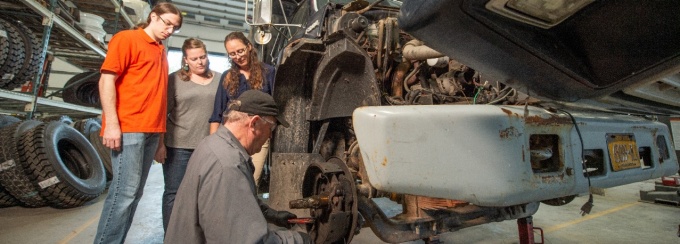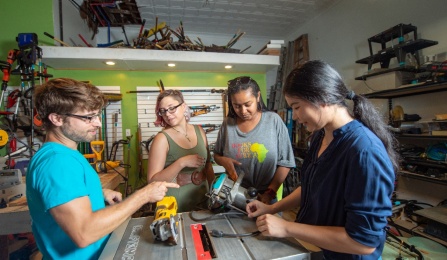Social Impact Fellows

A social work perspective to benefit the business world
Social Impact Fellows winning team employs social work in safeguarding builders at a for-profit company
By Jim Bisco
The second annual Social Impact Fellows (SIF) program last year resonated throughout the Western New York community, particularly in business. The SIF program pairs students from the schools of Social Work and Management to develop solutions to social issues at mission-driven area organizations and companies. And this year, the top prize in its Pitch for a Cause competition went to the student team that helped put Oneida Sales and Service on track for a culture shift in safety in the construction industry.
For the 2018 iteration, SIF was expanded to 10 teams and projects, with the addition of research associates from the College of Arts and Sciences to help with the team projects. Community nonprofits were in the majority of organizations with which the student teams worked. Projects ranged from students developing adaptive sports gear for blind and impaired athletes at the Olmsted Center for Sight, to the expansion of The Tool Library, an innovative tool rental program for neighborhood improvement in UB's South Campus community, which placed second in the pitch competition.
Social impact on the business world, however, was significant in taking first prize, emphasizing a rising awareness of the need for the personal perspective in the workforce.
Person-centered safety
For-profits should be for people, according to Maggie Saia, Oneida's safety director, who relates the philosophy of company president (and her father), Fred Saia. "He believes that if you focus more on people skills and the people side of things, you could wind up with a more productive company, and social workers have a skill set that a lot of business people don’t have," she said.
That philosophy laid out the welcome mat for Alyssa Bergsten, JD/MSW '19, and Aric Gaughan, MBA, '19, when they approached the company about developing a new, person-centered safety concept. "We used ‘person-centered’ as a way of explaining a multi-pronged approach to safety at Oneida," Bergsten said. "It helps focus on improving understanding of construction workers’ particular physical and mental health needs—building upon existing practices to make holistic safety discussions regular and relevant, and looking to construction workers as valuable sources of information in creating safety solutions."
The concept involved a transition from "safety cops" who more traditionally discipline after an infraction with a "suck it up and get back to work" mentality, to the idea of establishing "safety coaches" who work to create a positive, safe working environment. To develop the concept, the pair researched safety metrics and the prevailing construction industry psychology. They interviewed more than 60 construction workers, coming to the conclusion that Motivational Interviewing (MI)—an approach used by various mental health professionals, including social workers—would be the most effective approach in making the transition.
"We collected surveys, and we also heard input on working conditions, communicating with managers and third-party vendors, safety concerns, and logistical and interpersonal issues," said Bergsten. "We determined our best efforts would be to focus on the health of individual workers, the communication between Oneida's managers and employees, and the overall shift in culture toward a safety-focused approach."
After collecting and analyzing employee data, Bergsten and Gaughan also conducted qualitative interviews with several key managers to gain further insight into the organizational systems. That experience gave them a sense that the same MI techniques might be useful both among managers as well as between managers and employees.
"The idea of 'safety coach' encompasses how managers would approach employees in the fashion of an MI intervention," Bergsten said. "Rather than an authoritative, punishment-based approach, managers encourage positive employee behaviors by understanding them, making them feel heard, and incorporating their concerns into safety solutions. When people feel heard and can participate in problem solving, they are more likely to feel ownership and follow through with change."
Social Work significance
"With Alyssa and Aric's idea of changing the safety culture, we knew that was our goal," said Saia. "They helped us figure out a way to do it, using more of a social work perspective."
Maureen Hammett, SSW vice dean/chief of staff, who has played a role in the planning and execution of the SIF program, noted, "In helping Oneida make headway with this initiative, the fact that the primary technique used was borne out of a counseling/mental health approach is significant."
With ideas from several social work professors, Bergsten and Gaughan suggested bringing in a social worker experienced in Motivational Interviewing to train managers in the context of safety protocol implementation, including the application of a trauma-informed perspective.
Gaughan felt that they arrived at a solution gathered from both management and social work worlds. "While Alyssa led the survey crafting and questions, I tracked the results and looked for trends,” he said. “From there we spent time refining and developing how we communicated the worker-centered approach so that most any audience or listener could understand it. She and I saw things through similar lenses. We both understood how the industry was affecting workers mentally, and came to similar conclusions about the results of the surveys."
Saia noted that the implementation is still in its early stages of getting everyone on board. She sees this as a long-term initiative.
Real experience, real change
The whole experience gave Bergsten the opportunity to practice applying a gamut of social work skills. "It was a rare chance to be able to observe a system, develop ideas for positive interventions and make a plan to see them implemented, in only two months," she said. "My background is in nonprofit work, so I couldn’t have asked for a more drastic departure from that world. It was refreshing to meet people with a totally different knowledge base and interesting to observe the relationships and processes. The creative opportunity was really exciting; I hope to do this type of systems-level, policy-based work in the future."
Gaughan was encouraged by the company's positive response to the SIF team’s culture-shifting concept. "In order to continue implementing social work principles, the company will likely require consistent social worker presence until the ideas become second nature," he said. "The experience also gave me a taste of doing consulting, which I really enjoyed. I will likely continue to pursue that as a future career path."
Safety Director Saia is optimistic about the person-centered approach becoming the company—and industry—norm. "In the construction industry over the last five years, there’s been more of a push toward safety," she noted. "Oneida is often a subcontractor on our projects, so we're answering to a general contractor. More and more of those large general contractor companies ask about your safety records. They want to know what you're doing, how you're staying safe and what your plan is."
Saia sees her colleagues at Oneida being receptive to the new safety concept. "Overall, everybody's been very open to it,” she said. “We're shooting for a more collaborative approach rather than coming down with an iron fist and saying ‘this is what you have to do now.’"
Hammett is also encouraged that Oneida’s intent to help make that approach an industry standard, may have far-reaching significance. "That message, about amplifying or maximizing impact, was not only a winning idea but an idea that they intend to build from," she said. "It wasn't just going to be living within Oneida but ideally would be shared and spread beyond."
Hammett envisions the possibility of for-profit companies having a larger presence in future SIF competitions. "This is not just for the nonprofit world,” she said. “We see value for the students and the organizations on the for-profit side too. Reaching out to the for-profit side now, as with Oneida, will pay off in greater for-profit representation in the 2019 Social Impact Fellows program."

Students at the University Tool Library